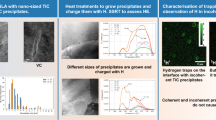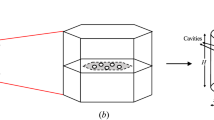Abstract
Deleterious environmental effects on steady-state, intrinsic fatigue crack propagation (FCP) rates(da/dN) in peak-aged Al-Li-Cu alloy 2090 are established by electrical potential monitoring of short cracks with programmed constant ΔK andK maxI loading. Such rates are equally unaffected by vacuum, purified helium, and oxygen but are accelerated in order of decreasing effectiveness by aqueous 1 pct NaCl with anodic polarization, pure water’ vapor, moist air, and NaCl with cathodic polarization. Whileda/dN depend on ΔK4.0 for the inert gases, water vapor and chloride induce multiple power laws and a transition growth rate “plateau.” Environmental effects are strongest at low ΔK. Crack tip damage is ascribed to hydrogen embrittlement because of acceleratedda/dN due to parts-per-million (ppm) levels of H2O without condensation, impeded molecular flow model predictions of the measured water vapor pressure dependence ofda/dN as affected by mean crack opening, the lack of an effect of film-forming O2, the likelihood for crack tip hydrogen production in NaCl, and the environmental and ΔK-process zone volume dependencies of the microscopic cracking modes. For NaCl, growth rates decrease with decreasing loading frequency, with the addition of passivating Li2CO3 and upon cathodic polarization. These variables increase crack surface film stability to reduce hydrogen entry efficiency. Small crack effects are not observed for 2090; such cracks do not grow at abnormally high rates in single grains or in NaCl and are not arrested at grain boundaries. The hydrogen environmental FCP resistance of 2090 is similar to other 2000 series alloys and is better than 7075.
Similar content being viewed by others
References
Aluminum-Lithium Alloys, T.H. Sanders, Jr. and E.A. Starke, Jr., eds., MCEP Ltd., Birmingham, United Kingdom, 1989, vols. I, II, and III.
Aluminum Alloys—Physical and Mechanical Properties Vols. I and II, E.A. Starke, Jr. and T.H. Sanders, Jr., eds., EMAS Ltd., Warley, West Midlands, United Kingdom 1986.
Aluminum-Lithium Alloys III, C. Barker, P.J. Gregson, S.J. Harris, and C.J. Peel, eds., Institute of Metals, Oxford, United Kingdom, 1986.
Aluminum-Lithium Alloys II, T.H. Sanders, Jr. and E.A. Starke, Jr., eds., TMS-AIME, Warrendale, PA, 1984.
Aluminum-Lithium Alloys, T.H. Sanders, Jr. and E.A. Starke, Jr., eds., TMS-AIME, Warrendale, PA, 1981.
K.T.V. Rao, W. Yu, and R.O. Ritchie:Metall. Trans. A, 1989, vol. 20A, pp. 485–97.
J. Glazer, S.L. Verzasconi, R.R. Sawtell, and J.W. Morris, Jr.;Metall. Trans. A, 1987, vol. 18A, pp. 1695–1701.
S. Suresh, A.K. Vasudevan, M. Tosten, and P.R. Howell:Acta Metall., 1987, vol. 35, pp. 25–46.
R.C. Dorward:Scripta Metall., 1986, vol. 20, pp. 1379–83.
R.G. Buchheit, J.P. Moran, and G.E. Stoner:Corrosion, 1990, vol. 46, pp. 610–17.
C. Kumai, J. Kusinski, G. Thomas, and T.M. Devine:Corrosion, 1989, vol. 45, pp. 294–302.
E.L. Colvin, G.L. Chen, Jr., G.E. Stoner, and E.A. Starke, Jr.:Corrosion, 1986, vol. 42, pp. 416–21.
P. Niskanen, T.H. Snders, Jr., J.G. Rinker, and M. Marek:Corros. Sci., 1982, vol. 22, pp. 283–304.
J.G. Craig, R.C. Newman, M.R. Jarrett, and N.J.H. Holroyd:J. Phys. Colloq. C3, 1987, suppl. 9, paper 48, pp. 825–33.
J.B. Lumsden and A.T. Allen:Corrosion, 1988, vol. 44, pp. 527–32.
R.C. Dorward and K.R. Hasse:Corrosion, 1988, vol. 44 (12), pp. 932–41.
A.K. Vasudevan, P.E. Bretz, A.C. Miller, and S. Suresh:Mater. Sci. Eng., 1984, vol. 64, pp. 113–22.
K.T. Venkateswara Rao, R.S. Piascik, R.P. Gangloff, and R.O. Ritchie: inAluminum-Lithium Alloys, T.H. Sanders, Jr. and E.A. Starke, Jr., eds., Materials and Component Engineering Publications Ltd., Birmingham, United Kingdom, 1989, pp. 955–71.
K.V. Jata and E.A. Starke, Jr.:Metall. Trans A, 1986, vol. 17A, pp. 1011–26.
K.T.V. Rao, W. Yu, and R.O. Ritchie:Metall. Trans. A, 1988, vol. 19A, pp. 549–61.
K.T.V. Rao, W. Yu, and R.O. Ritchie:Metall. Trans. A, 1988, vol. 19A, pp. 563–69.
N.J.H. Holroyd: inEnvironment Induced Cracking of Metals, R.P. Gangloff and M.B. Ives, eds., NACE, Houston, TX, 1990, pp. 311–46.
R.P. Gangloff: inEnvironment Induced Cracking of Metals, R.P. Gangloff and M.B. Ives, eds., NACE, Houston, TX, 1990, pp. 55–109.
J.A. Feeney, J.C. McMillan, and R.P. Wei,Metall. Trans., 1970, vol. 1, pp. 1741–57.
T.H. Shih and R.P. Wei:Eng. Fract. Mech., 1983, vol. 18, pp. 827–37.
J.C. Radon:Met. Sci., 1979, July, pp. 411–19.
M. Gao, P.S. Pao, and R.P. Wei:Metall. Trans. A, 1988, vol. 19A, pp. 1739–50.
R.P. Wei, P.S. Pao, R.G. Hart, T.W. Weir, and G.W. Simmons:Metall. Trans. A, 1980, vol. 11A, pp. 151–58.
J. Petit and A. Zeghloul: inEnvironmentally Assisted Cracking: Science and Engineering, ASTM-STP 1049, W.B. Lisagor, T.W. Crooker, and B.N. Leis, eds., ASTM, Philadelphia, PA, 1989, pp. 334–46.
F.J. Bradshaw and C. Wheeler:Int. J. Fract. Mech., 1969, vol. 5, pp. 255–68.
R.E. Stoltz and R.M. Pelloux:Metall. Trans., 1972, vol. 3, pp. 2433–41.
N.J.H. Holroyd and D. Hardie:Corros. Sci., 1983, vol. 23 (6), pp. 527–46.
M.O. Speidel, M.J. Blackburn, T.R. Beck, and J.A. Feeney: inCorrosion Fatigue, Chemistry, Mechanics and Microstructure, O. Devereux, A.J. McEvily, and R.W. Staehle, eds., NACE, Houston, TX, 1972, pp. 324–45.
A.M. Green and J.F. Knott: inAdvances in Fracture Research, K. Salama, K. Ravi-Chandar, D.M.R. Taplin, and P. Rama Rao, eds., Pergamon Press, New York, NY, 1989, pp. 1747–56.
F.S. Lin and E.A. Starke, Jr.: inHydrogen Effects in Metals, I.M. Bernstein and A.W. Thompson, eds., TMS-AIME, Warrendale, PA, 1981, pp. 485–92.
F.S. Lin and E.A. Starke, Jr.:Mater. Sci. Eng., 1980, vol. 43, pp. 65–76.
R.E. Ricker and D.J. Duquette:Metall. Trans. A, 1988, vol. 19A, pp. 1775–83.
A. Niegel, H.-J. Gudladt, and V. Gerold: inFatigue ’87, R.O. Ritchie and E.A. Starke, Jr., eds., EMAS, West Midlands, United Kingdom, 1987, pp. 1229–38.
A. Niegel, H.-J. Gudladt, and V. Gerold:J. Phys. Colloq. C5, 1988, vol. 49, pp. 659–63.
R.P. Wei and R.P. Gangloff: inFracture Mechanics: Perspectives and Directions, ASTM STP 1020, R.P. Wei and R.P. Gangloff, eds., ASTM, Philadelphia, PA, 1989, pp. 233–64.
F.P. Ford:Corrosion, 1979, vol. 35, pp. 281–87.
N.M. Grinberg:Int. J. Fract., 1982, April, pp. 83–95.
A.K. Vasudevan and P.E. Bretz:Fatigue Crack Growth Threshold Concepts, D. Davidson and S. Suresh, eds., TMS-AIME, Warrendale, PA, 1984, pp. 25–42.
R.P. Gangloff and R.O. Ritchie: inFundamentals of Deformation and Fracture, B.A. Bilby, K.J. Miller, and J.R. Willis, eds., Cambridge University Press, Cambridge, United Kingdom, 1985, pp. 529–58.
N.J.H. Holroyd, A.K. Vasudevan, and L. Christodoulou: inTreatise on Materials Science and Technology, A.K. Vasudevan and R.D. Doherty, eds., Academic Press, Boston, MA, 1989, vol. 31, pp. 463–83.
J.P. Moran: Ph.D. Dissertation, University of Virginia, Charlottesville, VA, 1990.
G.R. Yoder, P.S. Pao, M.A. Imam, and L.A. Cooley: inAluminum-Lithium Alloys, T.H. Sanders, Jr. and E.A. Starke, Jr., eds., MCEP Ltd., Birmingham, United Kingdom, 1989, pp. 1033–37.
P.S. Pao, M.A. Imam, L.A. Cooley, and G.R. Yoder:Corrosion, 1989, vol. 45, pp. 530–35.
K.S. Shin and S.S. Kim: inEffects of Hydrogen on Material Behavior, N.R. Moody and A.W. Thompson, eds., TMS-AIME, Warrendale, PA, 1990, pp. 919–28.
K.S. Shin and E.W. Lee: inLight Weight Alloys for Aerospace Applications, E.W. Lee, E.H. Chia, and N.J. Kim, eds., TMS-AIME, Warrendale, PA, 1989, pp. 171–79.
J.K. Donald: Fracture Technology Associates, Springtown, PA, unpublished research, 1989.
W.A. Herman, R.W. Hertzberg, and R. Jaccard:Fatigue Eng. Mater. Struct., 1988, vol. 11, pp. 303–20.
R.P. Gangloff:Metall. Trans. A, 1985, vol. 16A, pp. 953–69.
R.S. Piascik: Ph.D. Dissertation, University of Virginia, Charlottesville, VA, 1990.
R.S. Piascik and R.P. Gangloff: inAdvances in Fracture Research, K. Salama, K. Ravi-Chandar, D.M.R. Taplin, and P. Rama Rao, eds., Pergamon Press, New York, NY, 1989, pp. 907–18.
R.S. Piascik and R.P. Gangloff: inEnvironmental Cracking of Metals, R.P. Gangloff and M.B. Ives, eds., NACE, Houston, TX, 1990, pp. 233–40.
R.S. Piascik and R.P. Gangloff: University of Virginia, Charlottesville, VA, unpublished research, 1991.
H. Tada, P.C. Paris, and G.R. Irwin:The Stress Analysis of Cracks Handbook, Del Research Corp., St. Louis, MO, 1987, pp. 2–10.
R.O. Ritchie and J. Lankford: inSmall Fatigue Cracks, R.O. Ritchie and J. Lankford, eds., TMS-AIME, Warrendale, PA, 1986, pp. 1–5.
R.P. Gangloff: inAdvances in Crack Length Measurement, C.J. Beevers, ed., EMAS, Ltd., Warley, West Midlands, United Kingdom, 1982, pp. 175–229.
R.P. Gangloff, D.C. Slavik, R.S. Piascik, and R.H. Van Stone: inSmall Crack Test Methods, ASTM STP 1149, J.M. Larsen and J.E. Allison, eds., ASTM, Philadelphia, PA, in press.
R.P. Gangloff:Fatigue Eng. Mater. Struct., 1981, vol. 4 (1), pp. 15–33.
J.W. Swanson and H.L. Marcus:Metall. Trans. A, 1978, vol. 6A, pp. 291–93.
R.M.N. Pelloux:Trans. ASM, 1969, vol. 62, pp. 281–85.
D.A. Meyn:Trans. ASM, 1968, vol. 61, pp. 52–61.
R.P. Wei:Int. J. Fract. Mech., 1968, vol. 4, pp. 159–70.
D.J. Shaw:Introduction to Colloid and Surface Chemistry, Butterworth’s, Boston, MA. 1980.
P.S. Pao, Ming Gao, and R.P. Wei: inBasic Questions in Fatigue: Vol. II, ASTM 924, W.P. Wei and R.P. Gangloff, eds., ASTM, Philadelphia, PA, 1988, pp. 182–95.
D.L. Dicus: inEnvironment-Sensitive Fracture: Evaluation and Comparison of Test Methods, ASTM STP 821, S.W. Dean, E.N. Pugh, and G.M. Ugiansky, eds., ASTM, Philadelphia, PA, 1984, pp. 513–33.
Jing Gui and T.M. Devine:Scripta Metall., 1987, vol. 21, pp. 853–57.
R.G. Buchheit, F.D. Wall, G.E. Stoner, and J.P. Moran:Corrosion 91, NACE, Houston, TX, 1991, paper no. 99.
G.R. Yoder, L.A. Cooley, and T.W. Crooker:Scripta Metall., 1982, vol. 16, pp. 1021–25.
G.R. Yoder, L.A. Cooley, and T.W. Crooker: inFract. Mech.: 14th Symp., ASTM STP 791, J.C. Lewis and G. Sines, eds., ASTM, Philadelphia, PA, 1983, vol. 1, pp. 348–65.
G.R. Yoder, L.A. Cooley, and T.W. Crooker: inTitanium 80, Proc. 4th Int. Conf. on Titanium, H. Kimura and O. Izumi, eds., AIME, Warrendale, PA, 1981, vol. 3, pp. 1865–74.
R.J.H. Wanhill: inShort Crack Behavior in an Aluminum Alloy—An AGARD Cooperative Test Program, J.C. Newman, Jr. and P.R. Edwards, eds., AGARD Report No. AGARD-R-732, Annex A, Paris, France, 1989.
G.G. Garrett and J.F. Knott:Acta Metall., 1975, vol. 23, pp. 841–48.
A.J. McEvily and R.P. Wei: inCorrosion Fatigue: Chemistry, Mechanics and Microstructure, O. Devereux, A.J. McEvily, and R.W. Staehle, eds., NACE, Houston, TX, 1972, pp. 381–95.
D. Aliaga and E. Budillon:Corrosion Fatigue Behavior of Some Aluminum Alloys, AGARD Report No. AGARD-CP-616, Paris, France, 1981.
R.J. Selines and R.M. Pelloux:Metall. Trans., 1972, vol. 3, pp. 2525–31.
D.L. Davidson and J. Lankford: inFatigue Mechanisms: Advances in Quantitative Measurement of Physical Damage, ASTM STP 811, J. Lankford, D.L. Davidson, W.L. Morris, and R.P. Wei, eds., ASTM, Philadelphia, PA, 1983, pp. 371–99.
D.L. Davidson and J. Lankford:Mater. Sci. Eng., 1985, vol. 74, pp. 189–99.
Atlas of Electrochemical Equilibria in Aqueous Solutions, M. Pourbaix, ed., NACE, Houston, TX, 1974, pp. 168–76.
F.D. Bogar and T.W. Crooker: NRL Report 8153, Naval Research Laboratory, Washington, DC, 1977.
Markus O. Speidel:Metall. Trans. A, 1975, vol. 6A, pp. 631–51.
R.P. Wei, Ming Gao, and P.S. Pao:Scripta Metall., 1984, vol. 18, pp. 1195–98.
N.J.H. Holroyd and G.M. Seamans:Scripta Metall., 1985, vol. 19, pp. 915–16.
Author information
Authors and Affiliations
Additional information
ROBERT S. PIASCIK formerly Graduate Student, Department of Materials Science, University of Virginia.
Rights and permissions
About this article
Cite this article
Piascik, R.S., Gangloff, R.P. Environmental fatigue of an Al-Li-Cu alloy: part I. Intrinsic crack propagation kinetics in hydrogenous environments. Metall Trans A 22, 2415–2428 (1991). https://doi.org/10.1007/BF02665008
Received:
Issue Date:
DOI: https://doi.org/10.1007/BF02665008




